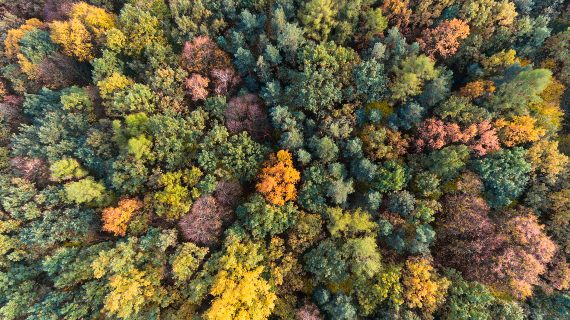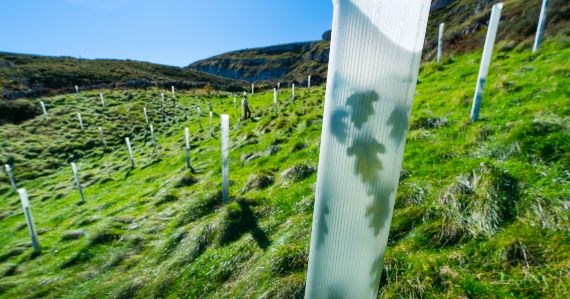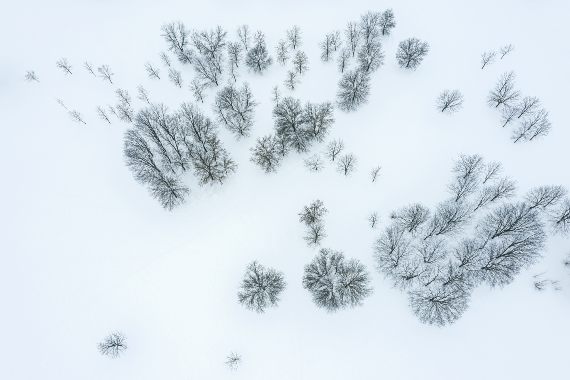Interview with Karen Holl, Professor of Environmental Studies at the University of California, Santa Cruz.
Why are ecosystems and forests so important for climate and how can they help fight it?
Forests and other ecosystems store a huge amount of carbon above and below ground. The most important thing we can be doing is to keep the existing forests and other ecosystems standing, not planting trees. Forests hold a lot of carbon in them, not only the trees you see but also the soil and roots below the ground. Wetlands and peatlands store a huge amount of carbon and mangrove forests, which are wetlands with trees, have some of the highest concentrations of carbon. So, we want to keep those existing forests and ecosystems there, not only because they store carbon, but because they do it now, whereas if we plant trees, we are going to have to wait. In addition, forests host a lot of biodiversity and we can never put ecosystems back together as well as they are now. This is why we are much better off keeping those ecosystems there.
Do all types of tree species store the same amount of carbon dioxide?
It is certainly species-specific how much carbon different trees store. In general, trees that grow very fast tend to have less dense wood, so they can sequester the carbon faster, but they don’t hold quite as much.

On the other hand, older trees grow slower but over the long term they’re probably going to sequester more. So it depends on the kind of tree and on how large it grows. People focus a lot on above ground carbon, there is also what is happening below ground. Some species will drop a lot of leaves and wood that might put carbon into the soil and there is carbon stored in roots. There are a lot of processes going on.
In the event of a wildfire, what happens to the carbon stored in the trees?
When a tree burns, carbon dioxide goes back into the atmosphere because it’s combusted, unless there is charred wood on the ground. In a wildfire there are often trees left standing which don’t burn. It really depends on the intensity of the wildfire. If the fire is not very intense, it can actually clear the understory and the trees that are adapted to fire grow larger. So it depends on what type of ecosystem the fire is in. But there is a lot of carbon that goes up into the atmosphere, particularly if the trees and the shrubs are killed. And so as fires become more intense, more carbon dioxide is being put back into the atmosphere.
Many politicians and company leaders are calling for the planting of millions of trees as a rapid and easy solution to climate change. What is your opinion?
My main answer is no, it is not a simple solution. First of all, we are not going to plant our way out of climate change. Right now we are in a very dire situation. We need to be doing everything we can and taking every strategy we can, but the biggest one we have to be doing is reducing our greenhouse gas emissions. We need to be reducing our travel, we need to be transitioning to green energy, we need to be reducing our consumption of beef which causes the release of methane and often results in the clearing of forest for pasture. We absolutely dramatically need to reduce our greenhouse gas emissions. We can’t plant trees instead of reducing greenhouse gas emissions. We need to be planting trees in addition to using every tool we can to slow climate change.

Second, the most important thing to do is to protect existing ecosystems first. People are planting all these trees in the Brazilian Atlantic Forest, but at the same time the Amazon is being cut down. We need to protect that forest. The same thing is happening in the United States, where there is talk about logging old-growth forests in Alaska, while we’re planting trees elsewhere. We need to protect those existing forests first, and also restore and reforest areas.
Third, tree planting is a lot more complicated, we have to do it right. We need to think about where to plant them. We need to take a long-term view and we need to include stakeholders.
What conditions should tree-planting meet in order to be really effective in the fight against climate change?
To do the tree planting right we have to include the communities. We need to plant the trees in the right place and make sure they survive and grow. This means planting trees in areas that were previously forested, not into grasslands. There’s been a lot of concern about planting trees in very northerly zones, because of what’s called albedo, that is, the reflectivity of the Earth’s surface. In places like Northern Canada or in those areas where there’s a lot of snow, a lot of the solar radiation is reflected back during part of the year. So if you plant trees, it makes it darker and it actually can cause heating. That’s one of the reasons people focus a lot on doing reforestation in the tropics and in lower temperate zones, because it doesn’t have that effect.
People talk about planting trees, but I believe we should actually be talking about growing trees. To achieve all the benefits that we want from tree growing (carbon sequestration, biodiversity conservation, water supply,…), the trees need to survive and grow. Groups should not only be thinking about how many trees they plant, but also how many trees are alive after five or ten years. At the same time, people are fixated on planting trees, but in a lot of cases, depending on the ecosystem, trees regenerate on their own, so they really don’t need to be planted.

Stakeholders are really important if you’re thinking of planting trees and projects should be led by local communities. When international organizations come in to plant trees, if people aren’t bought in and they’re not being compensated for the lost income from their land, they’re not going to maintain the trees. In some cases, tree planting has actually increased social conflicts. And there are a lot of examples where groups have planted trees and they haven’t been maintained over the long term, so money is just wasted. So the important questions to ask are: How are the local stakeholders involved? Why do they want to do this? And how are they getting money from this project?
One of my biggest concerns is that a lot of these projects are focused on one or two years and trees take much more time to grow. We’re going to pay the people to plant them and once the trees are planted, how are people getting money from the land? How do they benefit? It depends on the system. You can do some type of agroforestry, or what’s called silvopastoral systems, where people are grazing or doing agriculture within the trees. But if it’s not the case, people are being taken out of production and where are they going to go? What will their alternative livelihood be? Are they then going to clear the forest elsewhere? It’s what we call leakage or displacement, that is, you plant trees one way, and then people will go clear forests elsewhere. It has absolutely the opposite impact.
You have done quite a lot of research on forest restoration in places like Costa Rica. What have you learned?
I’ve worked in Costa Rica for a long time and we have been planting islands or patches of trees. The idea behind this is that that’s how forests recover naturally. We call it “applied nucleation” because these nuclei of trees spread out over time, creating a more heterogeneous forest and attracting birds and bats. That spreads over time and helps facilitate forest recovery. Our results after 18 years show that yes, the nuclei of trees we planted (about 25% of the area) do in fact attract birds and bats which disperse a lot of tropical forest tree seeds. So, it really facilitates recovery as much as these tree plantations, but we only had to plant 25% as much.

But this strategy doesn’t work everywhere. For example, one of my colleagues from Spain, José María Rey Benayas at the University of Alcalá, did an experiment planting what he calls “woodland islets” which are patches of oak tree plantings. 21 years after being planted, these islands of trees had hardly spread at all. And the reason behind this, we discovered, were the rabbits which were eating the tree seedlings around the edges. So, you need to have different strategies depending on where you’re working.
Another thing we have been doing in Costa Rica is comparing some of our plots which are right next to the forest with others which are out in the agricultural landscape, looking to see how important proximity to forests is for forest recovery. Surprisingly we found that it doesn’t have a huge impact. But that’s partly because, in this particular landscape, there are a lot of trees in the agriculture and they seem to provide sources of seeds and facilitate movement of animal species. So being near the remnant forest affects the flora and fauna in the restored sites but not as strongly as you would expect. I think the result would be quite different if we were in a landscape where there weren’t as many trees in the agriculture.
What is your opinion on genetically modifying plants/trees to increase their carbon storage capacity?
It’s an interesting idea that makes sense. Environmentalists are generally very worried about genetically modifying organisms and my attitude towards this is that we need to do it cautiously. We’ve been grafting and modifying trees for hundreds of years. We need to be careful that they’re not invasive and that we’re not doing things that can be risky, but I’d have to say that it makes sense.
Comments on this publication